Review of Django Kill
Introduction
I used to think that I was a fan of Spaghetti Westerns, a European industry that revitalised a fading genre with a gritty, realistic take on the cowboy. Yet when I consider the films I do like, A Fistful Of Dollars, For A Few Dollars More, Once Upon A Time In The West, A Fistful Of Dynamite, and The Good, The Bad and The Ugly, I`m left with the dawning realisation that it is actually Sergio Leone films that I like, and my exposure to other Spaghetti Westerns has been woefully limited. It`s fortunate then that I was sent Django Kill to review, a Spaghetti Western directed by Giulio Questi, with the curious endorsement "The most brutally violent Spaghetti Western made".
Django Kill had a typically awkward genesis, with various versions released with different names. The Franco Nero film, Django was doing big business, when If You Live, Shoot (as it was originally called) was released, so the title was quickly changed to Django Kill, despite having nothing to do with the original film. The original release was censored for violence and the British release even more so, but times have changed, and this DVD release has those scenes re-instated, with two scenes still in the original Italian with English subtitles.
A stranger pulls himself out of a makeshift grave, having been left for dead by his gang, after an audacious gold robbery that ended in betrayal. He is discovered by a couple of Indians who nurse him back to health, and use the gold to forge bullets with which he can wreak vengeance on those who wronged him. His gang have made it to a village known to the Indians as `The Unhappy Place`, where they attempt to buy horses, but the villagers have other ideas and violence erupts. When The Stranger gets to town, he learns that his bullets won`t be wasted on those who betrayed him, but now he has to contend with the depraved inhabitants of the town, the saloon owner and the Alderman who`s partnership has deteriorated into conflict over who deserves the bandits gold, as well as wealthy land owner Zorro, whose `muchachos` are terrorising the town into giving up the gold. Let the backstabbing and betrayal commence.

Video
The picture quality is initially promising. The 2.35:1 anamorphic transfer is stated as having been restored from the original negative materials, and the image is initially impressive. It`s clear and sharp, with strong vibrant colours and only a hint of grain. The problem is that while the majority of the film has a fresh feel that belies its nearly 40 years of age, occasionally there will be a burst of strong print damage that is jarring in its severity, and actually looks out of place next to the film. I guess it`s a testament as to how good the final restoration actually was.
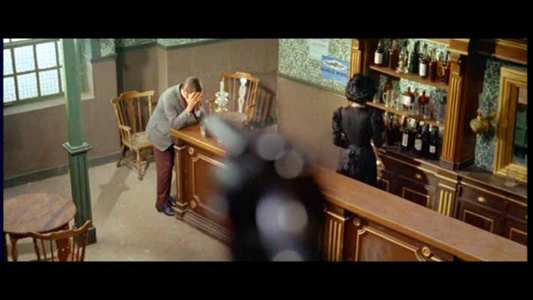
Audio
The sound on the other hand hasn`t been subjected to the same rigorous restoration. It`s a DD 2.0 English mono track, except for the restored scenes in Italian, and the dialogue is audible enough, but there are one or two dropouts in sound, and there are plenty of pops and crackles, although it is remarkably free of hiss. The dialogue is awful for the most part, and there is no attempt at accurate lip-synching for the dub (or the Italian track for that matter). In that respect it`s an exemplary example of the Spaghetti Western stereotype. The music was initially enjoyable, but there is only the one theme, and by the end of the film, I was utterly sick of hearing the same few notes over and over again. The only subtitles on this film are for the Italian dialogue in the restored scenes, otherwise you`ll have to do without. The layer change is poorly placed in the middle of a line of dialogue.

Features
The disc has some animated menus taken from the film. All well and good, but the problem is that when you switch between menus, the transition takes on the order of a minute, which is incredibly annoying.
The most substantial addition to this disc is a 27-minute interview with director Giulio Questi and actor Ray Lovelock. In a thoughtful move, the featurette begin with a spoiler warning, advising you to watch the film first. The interview is presented in 4:3 and DD 2.0 Italian with English subtitles. It`s your standard retrospective making of, with thoughts on the genesis of the film, the production and how it was censored.
An Introduction To Django Kill is an 8-minute piece presented by Alex Cox in 1.85:1 anamorphic. Again it starts with a spoiler warning, and Alex Cox goes on to provide his insight regarding the film. Considering that Django Kill inspired one of his own films, you won`t be surprised to hear him practically enthuse about the original film. It`s an informative piece though.
The Django Kill trailer is a rip-off of the animations used as title sequences in the Man With No Name trilogy.
The Argent Westerns Trail has trailers for four other Spaghetti Westerns available in this range. You can see trailers for Django, A Bullet For The General, Keoma and Texas, Adios. They all look more interesting than Django Kill.
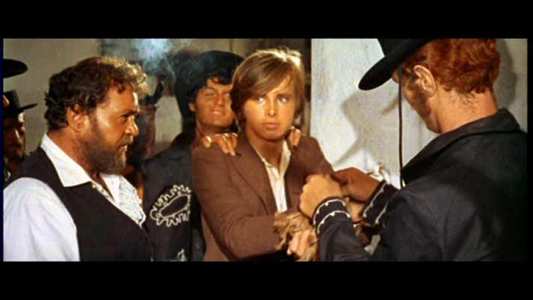
Conclusion
Django Kill ultimately turned out to be a disappointment, not least because of the rather dated endorsements. It may have been "the most brutally violent Spaghetti Western made" in 1967, but today it`s tame when compared to contemporary films. Having said that, the torture scene in The Good, The Bad and The Ugly outdoes this film in terms of brutality. Hyperbole aside, the story itself has a rather common revenge theme, but I don`t feel that it is adequately explored.
The film begins promisingly enough, with Thomas Milian`s enigmatic stranger left for dead by the members of his gang. His `resurrection` and subsequent healing set up a desire for vengeance that is sealed by the forging of the golden bullets. When he sets out in pursuit of his betrayers, the scene switches and we see the betrayers arrive in the village. The subsequent events render The Stranger`s desire for revenge moot, and in effect reset the film back to the beginning. We are then introduced to a whole new set of characters and in essence the story begins again. The Stranger first motivated by vengeance, now becomes an observer as the village tears itself apart over the stolen gold. This false start poses a sense of detachment from the film, and it is hard to empathise with any of the characters. This isn`t helped by Giulio Questi`s rejection of the narrative in favour of vignettes and imagery. This film is a series of tenuously connected events meant to shock in terms of escalating violence and depravity, as the Stranger drifts from one scene to another. The result, whilst visually impressive is poorly written, riddled with plot holes and ultimately unsatisfying.
The restored scenes are a mixed bag as well. The lapse into Italian isn`t as jarring as you would expect, Spaghetti Westerns aren`t heavily loaded with dialogue in the first place. The scalping scene is useful only in that it fills a potential plot hole, but it doesn`t really serve much other purpose. The other restored scene is striking though. One of the men that The Stranger shoots is taken into the saloon to be operated on by the local quack. When he removes a bullet and finds it to be made of gold, the townspeople descend on the still living victim and literally tear him apart searching for other gold bullets lodged in his body. It`s a powerful scene that effectively establishes the gold fever and greed that motivates the townspeople and it adds strongly to the nihilistic tone of the film.
The film`s themes are certainly influential, with The Stranger effectively resurrected to wreak vengeance on those who betrayed him, and when he comes upon the town, he leaves devastation in his wake. The gold that began the whole tale is cursed in that it destroys all who come into contact with it, beginning with the thieves who stole it in the first place. In the end it`s worth noting that no one gains any of the riches. It`s a strong, almost supernatural thread that reminded me of Clint Eastwood`s High Plains Drifter.
The direction is flamboyant and stylish, with much to be enjoyed about the visual inventiveness of Giulio Questi. I especially enjoyed the shootout between The Stranger and one of his gang in a general store. The performances are variable, but all the main characters are brought to vivid, avaricious, backstabbing life. The lack of a coherent narrative makes this film a chore to watch. Just like the film itself, I wound up just drifting along for the 2 hours. As for the violence, I think contemporary audiences will be more offended by the sight of a dog being kicked rather than anything else. The image on this disc may be vibrant, but it is let down by some print damage and the sound is barely acceptable. The extras are a nice addition, but I wouldn`t call Django Kill an essential purchase.
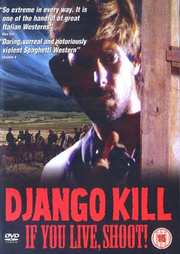
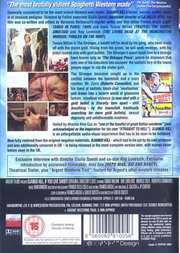
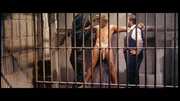

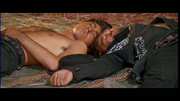

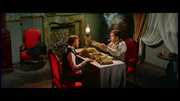
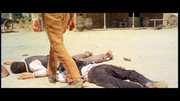
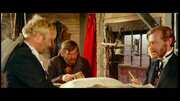



































Your Opinions and Comments
Be the first to post a comment!